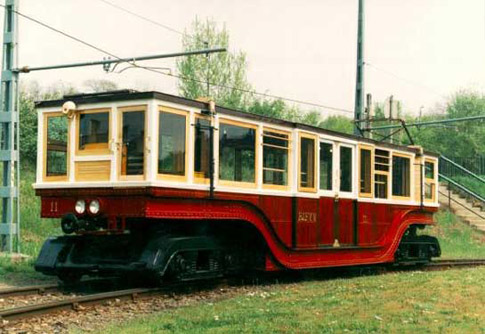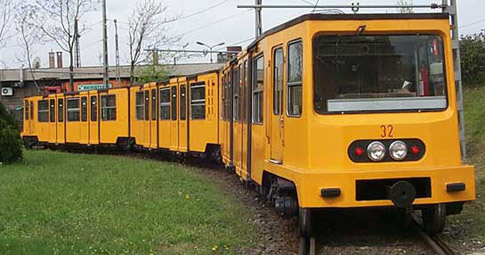The last decades of the 19th century represent a decisive period in Budapest's development also on a historical scale. Formation of the axis of Andrássy út (avenue) can be considered as one of the outstanding formations of urban development. In a first concept, the Council of Public Works established in the summer of 1870, the term avenue has already been mentioned as a starting point, and already in that very year its exact alignment and division into three sections have also been set. A relevant plan of development and budget were prepared, then the Parliament approved its implementation in December 1870.

The Council of Public Works opposed from the beginning to the implementation of a surface fixed trajectory public transport on this avenue. In compliance with the proposal of Mr. Mór Balázs, the Council more and more considered the thought of an underground railway. The Siemens and Halske Company prepared the plans for this concept, and the Council accepted it with one condition, namely that it can only be commenced if completed by 1896, the Millennial festivities.
Being the first underground railway of the continent, the railway was made available for the public from May 2, 1896, and has been used without any major troubles so far. In 1973, the length of the line amounted to 3700 meters, including 9 underground and 2 surface stations. Headway was two minutes, and the highest number of passengers was 34,526 a day.
As for technical standard, the quality of the underground railway in general and the rolling stock outreached its era by far at the time of inauguration. Travel was provided by bogie motor cars, and power supply was ensured by a steam machine driven generator. The signalling system operated as long as until 1973 in its original condition.
The line obtained its present form in 1973, when the surface section was eliminated, the shortest stations were lengthened and a new depot was constructed, to which the line was extended outside the Városliget region. The signalling system was updated at the same time, and "right side" driving was introduced instead of "left side" driving with new Ganz cars. Since then the trains run between Mexikói út and Vörösmarty tér .
From the middle of 1980s, severe damage and deterioration indicated the necessity of a reconstruction. The track was deteriorated to such extent that its immediate reconstruction became indispensable. Top waterproofing of the tunnel were mostly damaged, the floor slabs were leaking and, consequently, the floor structure had to be reinforced.
On the basis of such investigations, BKV prepared a plan of reconstruction of three years, and in 1987 commenced its implementation.Unfortunately only works envisaged for 1988 could be completed. The tunnel slab was reinforced all along Andrássy út by reducing the distances between supports. Waterproofing of side walls and the base plate were renewed between Hősök tere and Kodály körönd and the surface roadway was also renewed.
Rehabilitation of the Millenium Underground Railway - 1995
Track reconstructionThe situation became more and more severe, and in 1992 the condition of the track could not guarantee any more safe operation even by imposing speed limitations. The reconstruction had to be continued at any price. The tasks to be fulfilled were track construction and structure renewal.
As the first step of the reconstruction of the obsolete track section between Bajcsy Zs. út and Hősök tere, the rails were cut into pieces and removed from the tunnel. Following the removal of sleepers the ballast bed had to be demolished. The working area of extreme narrow cross section was the main difficulty in this phase. Side walls and floors of the tunnel were cleaned with high pressure water jet. Metal structures received special corrosion protection coating. In the following, the reinforcement of the deck plate was prepared. Concrete was poured to its final place by pumps installed in stations.
The new track section received welded continuous rails of 48.5 kg/m, glued on reinforced concrete beds with the spacing of 750 mm. Following the transport and distribution of rails on site, the track was adjusted to proper direction and height parameters in compliance with plans. Then boreholes were formed in the track slab at the locations of fastening elements. A rail switch was constructed within this reconstruction at Oktogon tér station, which enables sectioning and independent operation of the divided line.
Reinforcement of the 100 year old tunnel slab and installation of new waterproofing on the entire upper part was only possible from the surface, thus, reconstruction of the entire Andrássy út was reasonable to carry out on this occasion.
At Oktogon tér a track connection was constructed to enable line sectioning and the reversal of trains. That is why the old slab had to be demolished in 60 m length and a new slab was constructed. In order to restore traffic on Nagykörút , a new slab was constructed using pre-cast elements. This operation was combined with the reinforcement and waterproofing of the top slabs at Deák tér and Vörösmarty tér.
Out of the 11 stations of the Millennial underground railway 8 stations are original and 3 stations were constructed within various line reconstruction works. Internal renewal of stations, representing historical value, was performed in compliance with their original style, with original coverings and design. Demolishing works at Bajza utca station could only be commenced later since the materials used for internal decoration of the historical stations were presented to the public and experets at this very station. The colour of DECO-REZ floor coverings was selected, as well as the Haidecker fence separating the platforms from each other, the shape of fence and cable supports, the colour of steel piles and ceilings, a skid-proof granite covering for safety lanes, and the pattern of tile linings etc. were decided.
The works carried out in the new stations covered stone linings, aluminium doors and windows, construction of suspended ceilings, and in the historical stations the preparation of a wall covering similar to the original Zsolnay-brand tiles.
The cars were equipped with new upholstered seats, fire and vandalism-resistant decorative sheet covering, plastic floor covering, new passengers' strap handles made of leather, as well as illuminators. The cars received a new external painting.

A travel recording device ("black box") was installed in the renovated cars, as well as an equipment enabling communication between the driver and the passengers. In order to improve the running safety of trains, tunnel frames and bogies were replaced, including their auxiliary components. Newly installed static transformers are used to supply the light tube fittings in the passenger compartment.
Organisations participating in renovation:
Client: Mayor's Office of Budapest Capital city, Programme Bureau of EBRD
Investor: BKV Rt., Transport Department of the Mayor's Office of Budapest Capital City
Engineer: Metróber Ltd. - Eurout Ltd.
Designer: Főmterv Co., Uvaterv Co.
Assistant Designer: MÁVTI Ltd.
Main Contractors: Betonútépítő Co., Hídépítő Co., Strabag Hungária Ltd., BKV Co., Sasib SpA, Ganz Hunslet Co.
Sub-Investors: Fővárosi Csatornázási Művek Co., Fővárosi Vízművek Co., Budapesti Elektromos Művek Co.
Copyright:
Text: Publication of Budapest Local Government entitled "100 Years Past - 100 Years Future", and BKV Rt.'s publication: "Millenium Underground Railway is 100 years old".
Useful Links:
Passenger Information
Metro Maps





